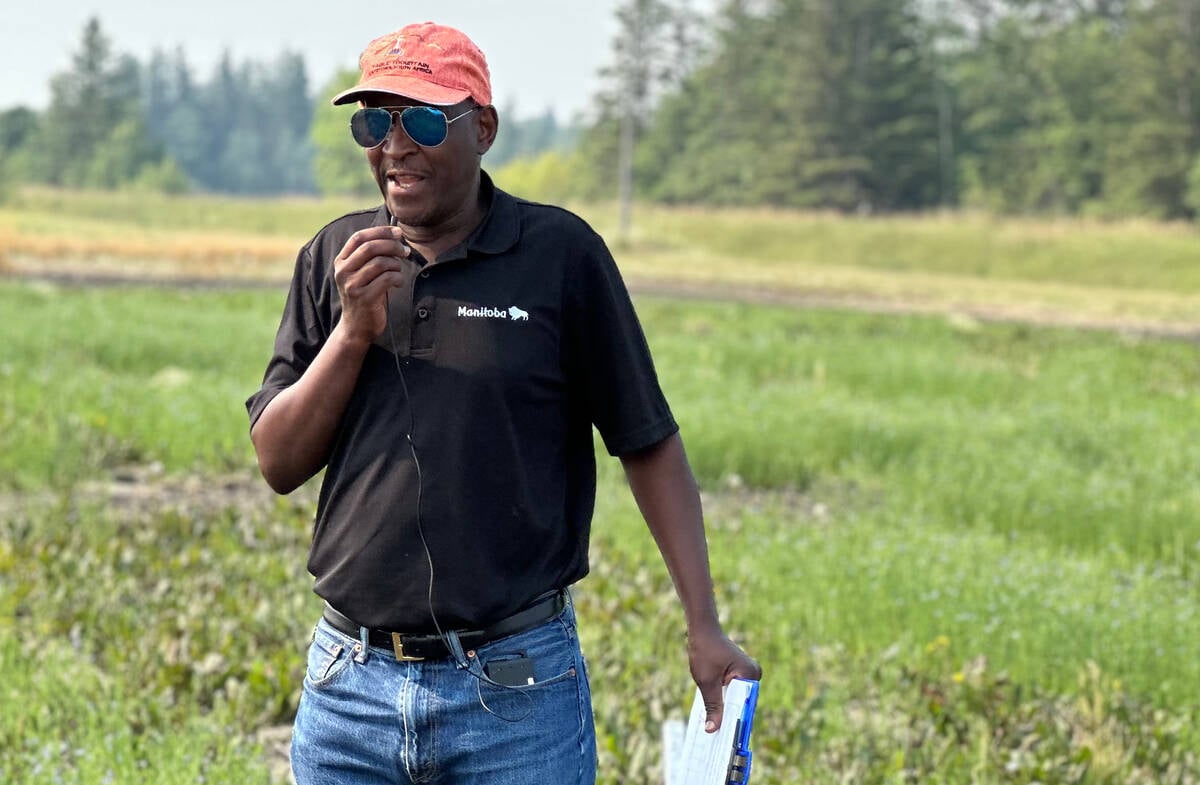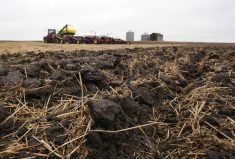Sleek white anhydrous ammonia fertilizer tanks perched on wheels ready to roll out to farmers’ fields were once a common sight along rural highways.
Not so anymore.
The apparent case of the missing anhydrous tanks has some wondering if it’s just an aberration, or if it signals a quiet but significant change in farmers’ soil fertility practices.
Doug Chorney thinks it does. A longtime anhydrous ammonia (NH3) user, Chorney says he has seen the number of anhydrous sites decrease throughout Manitoba in recent years. He worries the trend may continue.
Read Also

How much nitrogen can farmers really cut?
Manitoba fertilizer trials look for nitrification inhibitor sweet spot, to lower greenhouse gas emissions and cost without hurting yield.
“We’re still committed to using anhydrous ammonia,” said Chorney, a former Keystone Agricultural Producers president who farms near Selkirk. “I don’t think we’re going to see it completely disappear overnight. But there’s definitely a trend here.”
Corroborating data is difficult to find. The Canadian Fertilizer Institute tracks the movement of all fertilizer, not specific types. The Manitoba Agricultural Services Corporation summarizes fertilizer application rates for various municipalities, but does not keep records on total sales. Agrium Inc., which controls 46 per cent of the ammonia plant capacity in Canada, reports no market change for anhydrous ammonia over the last three to five years.
“There hasn’t been a diminishment of uptake,” said Ray Dowbenko, Agrium’s senior agronomy specialist in Calgary. “As far as our numbers go, everything’s pretty much the same as it has always been.”
Even so, there are signs that anhydrous ammonia, once the king of nitrogen fertilizers, may be starting to play second fiddle to its granular and liquid cousins.
Chicken and egg
It’s a chicken-and-egg argument as to whether agri-retailers are backing away from anhydrous ammonia or if farmers are just using it less. But Chorney feels the traditional practice of banding fertilizer in fall has declined significantly in Manitoba because the recent series of wet springs affected producers’ ability to seed.
“That has made farmers very leery of putting fertilizer down so far in advance of growing a crop,” Chorney said. “So that means less demand, and therefore dealers are really evaluating the viability of having the anhydrous ammonia distribution system they used to have.”
Safety is another reason why retailers may hesitate to carry anhydrous. NH3 is a hazardous material and accidental spills can cause environmental and human health hazards. A prime example occurred on January 18, 2002, when a Canadian Pacific train derailed near Minot, North Dakota and tanker cars carrying anhydrous ammonia ruptured. A cloud of poisonous gas was released, killing at least one person and injuring about 100 more.
Safe handling and strict regulations are among the reasons why Cargill, once a major anhydrous supplier, decided not to provide it after the 2015 spring season.
“Our reason for exiting the NH3 market was because Cargill strives to provide customers with excellent service in a timely manner while protecting our employees and customers from the risks associated with handling anhydrous ammonia,” a company spokesperson said in an email to the Co-operator. “Taking this into consideration, along with the increasing costs and the potential additional regulations, we decided other organizations are better fit for the longer-term investment required to comply with dangerous goods legislation.”
Because the storage and handling of anhydrous ammonia is regulated, producers are not allowed to keep it on their farms, as they can with other fertilizers. They must either go to an approved site to pick up portable anhydrous tanks or else have them delivered to their farms. This can make anhydrous ammonia inconvenient to use, especially if you’re seeding thousands of acres and have to run back and forth to get more as you need it.
Logistics
So, in order to stay flexible when planting crops, farmers may be using less anhydrous because of logistical challenges with the ammonia pipeline, suggests Don Flaten, a University of Manitoba soil scientist professor.
“That’s one of the biggest issues with ammonia,” said Flaten. “There’s no agronomic reason not to use anhydrous ammonia. In fact, there’s lots of good agronomic reasons for using it. The biggest challenge is logistics.”
Ironically, anhydrous ammonia is the most efficient and cost-effective form of nitrogen fertilizer. It consists of 82 per cent nitrogen, whereas granular urea is 46 per cent (46-0-0) and the liquid solution form (urea ammonia nitrate or 28-0-0 UAN) is 28 per cent.
Because granular urea and UAN have a lower nitrogen concentration, you need to handle more in order to apply the same amount of N as anhydrous. (Chorney compares it to having to carry four shopping bags of potatoes to the car instead of just one.) As a result, anhydrous gives you better value for your nitrogen dollar.
“Fundamentally, ammonia is the lowest-cost fertilizer for nitrogen source and it’s extremely efficient and effective,” Flaten said.
However, urea and UAN have one big advantage. Producers can take delivery when there’s a good price and store the products on their farms. At the same time, storage requires liquid tanks and fertilizer hopper bins, which can be expensive.
Efficiency
However, new technologies may be making urea and UAN more efficient to use. Flaten says farmers are increasingly switching to a one-pass seeding and fertilization system. The all-in-one approach makes logistical support for urea and UAN is better because, unlike anhydrous, they can be stockpiled in advance and used when needed.
New air seeder carts designed to handle large volumes of granular N also make urea increasingly attractive. Chorney says he saw a 1,300-bushel cart at the last Farm Progress Show in Regina, which dwarfs the 350-bushel cart he uses on his farm.
So far, reports about the demise of anhydrous ammonia are mostly anecdotal. Agrium’s Ray Dowbenko suggests the reason there appear to be fewer NH3 bullet tanks may be that companies are moving them further away from major highways as a safety precaution. Also, some agri-retailers who recently consolidated operations may be rationalizing facilities and closing down redundant sites.
Myron Kroeker, a partner with Rosenort Agro Ltd., says his business is generally able to get the anhydrous customers need. But he acknowledges that safety concerns, supply logistics and the disappearance of small independent dealers may eventually affect the future of anhydrous ammonia.
“I sure hope it stays around,” said Kroeker. “Once we lose it, it’s gone.”















